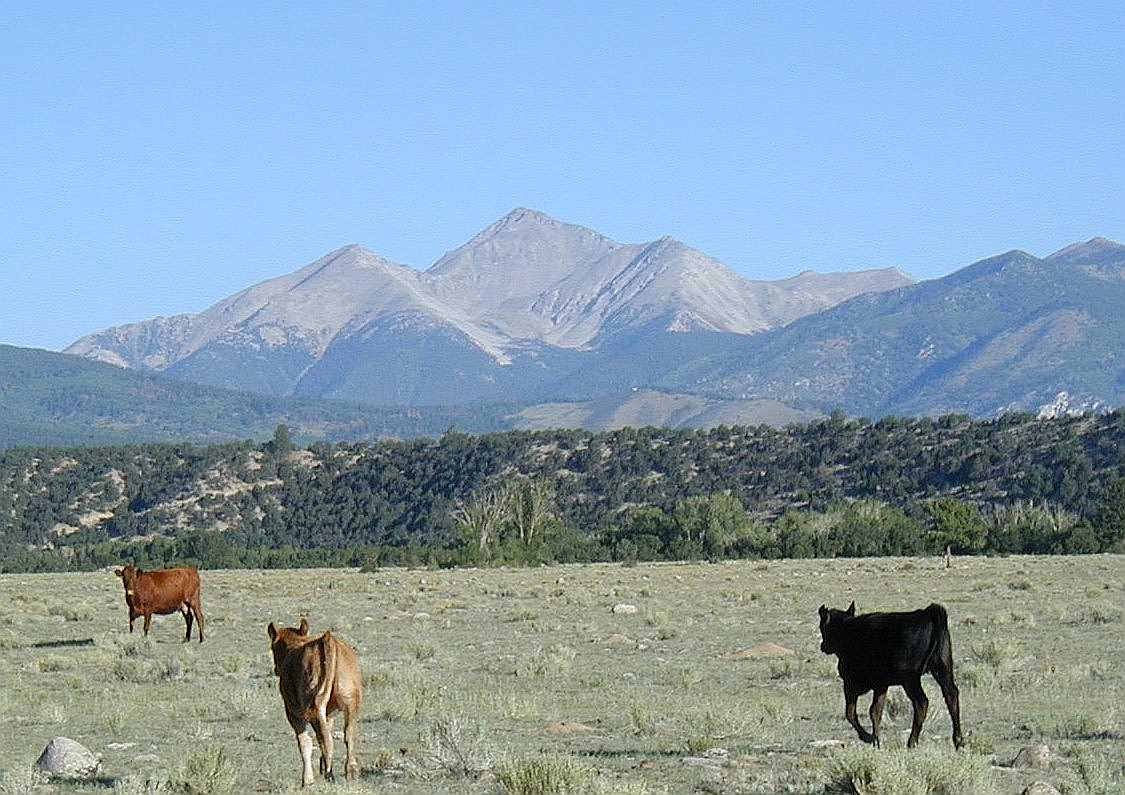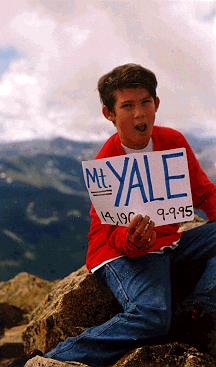Mt. Yale
Elevation 14,196 feet (4,327 m)
 Mt. Yale was named in 1869 by an expedition led by Josiah
Whitney, for whom the tallest mountain in the lower 48 US
states is named. Mt. Yale is found among the
Collegiate
Peaks of the
Sawatch Range. The first recorded climb of Mt. Yale was
made by Whitney and four others on August 18, 1869. Our own
ascent was on September 9, 1995.
Mt. Yale was named in 1869 by an expedition led by Josiah
Whitney, for whom the tallest mountain in the lower 48 US
states is named. Mt. Yale is found among the
Collegiate
Peaks of the
Sawatch Range. The first recorded climb of Mt. Yale was
made by Whitney and four others on August 18, 1869. Our own
ascent was on September 9, 1995.
A2 maintains that Yale has been the toughest of the 13
Fourteeners we have climbed (at that time!); Klaus holds that distinction for
Mount Massive. Either way, though
no technical climbing is required, the Mt. Yale trail is
pretty steep in places; it gains 4,400 feet in about three and
a half miles.
We camped at Collegiate Peaks Campground the night before
our ascent. Fortunately, the campground was almost deserted,
since it was a few days after Labor Day. We had planned on
taking the Denny Gulch route described in some places as
the easiest, most direct route, but found to our dismay that
the trail was closed due to overuse. Fortunately, a small
quarter mile hike west on Colorado highway 306 brings you to
Denny Creek, where an alternate trail leads its way up to Mt.
Yale. (Both trailheads are marked along side of the highway,
just west of the campground turnoff.)
 We hit the trail at 7:17 am, trudging up a quite steep path
leading north from the highway. After a bit, the trail levels
out and you glide along, gradually going up Delany Gulch
until you reach its head. Then the nature of the trail changes
dramatically, as it heads steeply up the side of the gulch
till you finally top out just around timberline. A few years
ago we would have had to bushwack this section;
thankfully, a good trail now exists, though we had to take
breaks often because it was so steep.
We hit the trail at 7:17 am, trudging up a quite steep path
leading north from the highway. After a bit, the trail levels
out and you glide along, gradually going up Delany Gulch
until you reach its head. Then the nature of the trail changes
dramatically, as it heads steeply up the side of the gulch
till you finally top out just around timberline. A few years
ago we would have had to bushwack this section;
thankfully, a good trail now exists, though we had to take
breaks often because it was so steep.
We reached timberline at 9:20 and encountered the first people
we'd seen on the trail that day. Once you get above the trees,
you get your first view of Mt. Yale and the approach to the
saddle west of the summit. From here (about 13,600 ft.), the
trail leads directly toward the saddle.
Once you've made the crest of the saddle, though, you've
done the hardest part. Now just follow the ridge southeast
to the summit. Actually, we believe the best route to be
just to the south of the top of the ridge. Your view isn't
as nice as it would be traveling on the top of the ridge, but
the going is alot easier (as we found out during our trip
down).
We got to the top at noon and shared lunch with three fellows
and a dog who'd come up using a longer trail from the east. Bad
weather approaching from the west drove us off the summit at
12:30. We scrambled down through the snow as quickly as we could,
knowing the danger of lightning above timberline. We found out
the following day that someone had been struck and killed by
lightning that day on
the next peak over, reinforcing how
exposed you are when above the trees and how you need to descend
to take cover when thunder and lightning threatens to come your way.
We made it back to camp at 4:20 pm.
Hike Back To Our Homepage
This page hosted by  Get your own Free Home Page
Get your own Free Home Page
 Mt. Yale was named in 1869 by an expedition led by Josiah
Whitney, for whom the tallest mountain in the lower 48 US
states is named. Mt. Yale is found among the
Collegiate
Peaks of the
Sawatch Range. The first recorded climb of Mt. Yale was
made by Whitney and four others on August 18, 1869. Our own
ascent was on September 9, 1995.
Mt. Yale was named in 1869 by an expedition led by Josiah
Whitney, for whom the tallest mountain in the lower 48 US
states is named. Mt. Yale is found among the
Collegiate
Peaks of the
Sawatch Range. The first recorded climb of Mt. Yale was
made by Whitney and four others on August 18, 1869. Our own
ascent was on September 9, 1995.
 We hit the trail at 7:17 am, trudging up a quite steep path
leading north from the highway. After a bit, the trail levels
out and you glide along, gradually going up Delany Gulch
until you reach its head. Then the nature of the trail changes
dramatically, as it heads steeply up the side of the gulch
till you finally top out just around timberline. A few years
ago we would have had to bushwack this section;
thankfully, a good trail now exists, though we had to take
breaks often because it was so steep.
We hit the trail at 7:17 am, trudging up a quite steep path
leading north from the highway. After a bit, the trail levels
out and you glide along, gradually going up Delany Gulch
until you reach its head. Then the nature of the trail changes
dramatically, as it heads steeply up the side of the gulch
till you finally top out just around timberline. A few years
ago we would have had to bushwack this section;
thankfully, a good trail now exists, though we had to take
breaks often because it was so steep.